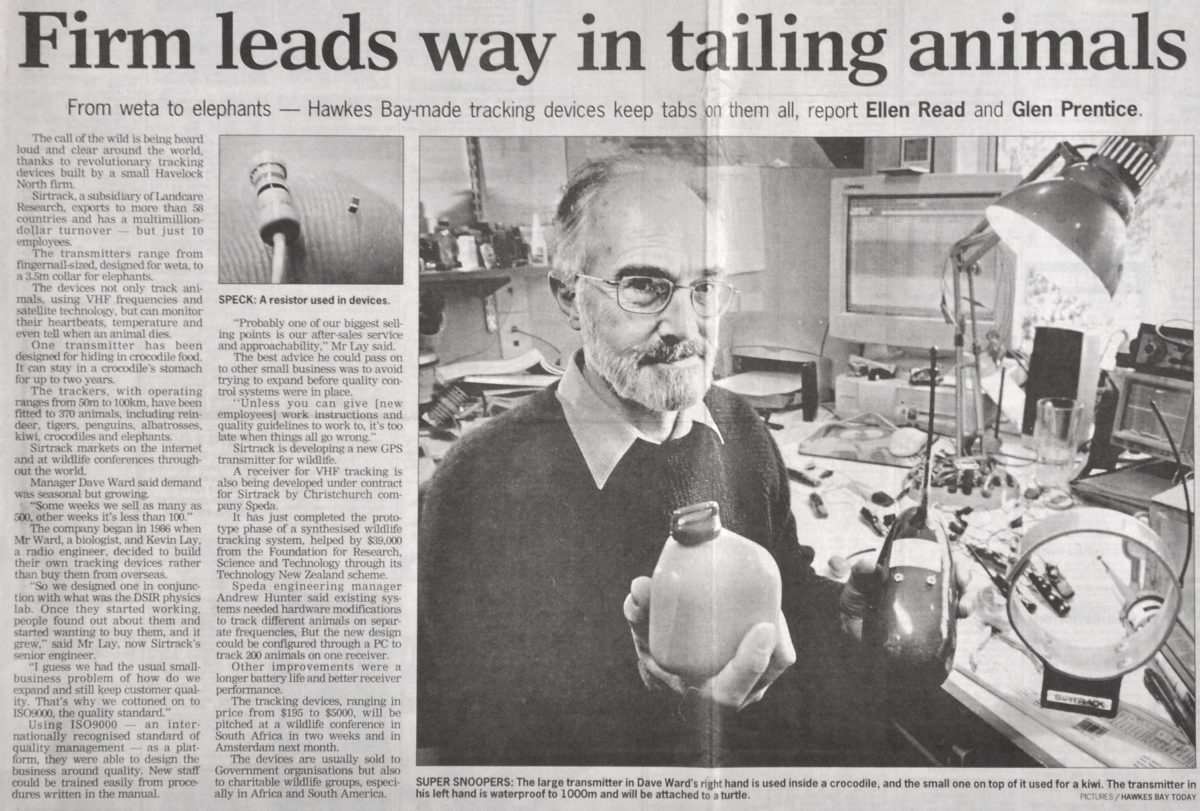Firm leads way in tailing animals
From weta to elephants – Hawkes Bay-made tracking devices keep tabs on them all, report Ellen Read and Glen Prentice.
The call of the wild is being heard loud and clear around the world, thanks to revolutionary tracking devices built by a small Havelock North firm.
Sirtrack, a subsidiary of Landcare Research, exports to more than 58 countries and has a multimillion dollar turnover – but just 10 employees.
The transmitters range from fingernail-sized, designed for weta, to a 3.5m collar for elephants.
The devices not only track animals using VHF frequencies and satellite technology, but can monitor their heartbeats, temperature and even tell when an animal dies.
One transmitter has been designed for hiding in crocodile food. It can stay in a crocodile’s stomach for up to two years.
The trackers, with operating ranges from 50m to 100km have been fitted to 370 animals, including reindeer, tigers, penguins, albatrosses, kiwi, crocodiles and elephants.
Sirtrack markets on the internet and at wildlife conferences through-out the world.
Manager Dave Ward said demand was seasonal but growing, “Some weeks we sell as many 500, other weeks as less than 100.”
The company begin in 1986 when Mr Ward, a biologist, and Kevin Lay, a radio engineer, decided to build their own tracking devices rather than buy them from overseas, “So we designed one in conjunction with what was the DSIR physics lab. Once they started working, people found out about them and started wanting to buy them, and it grew.” said Mr Lay, now Sirtrack’s senior engineer.
“l guess we had the usual small-business problem of how do we expand and still keep customer quality. That’s why we cottoned on to ISO9000, the quality standard”
Using lSO9000 – an inter-nationally recognised standard of quality management – as a platform, they were able to design the business around quality. New staff could be trained easily from procedures written in the manual.
“Probably one of our biggest selling points is our after-sales service and approachability.” Mr Lay said.”
The best advice he could pass on to other small business was to avoid trying to expand before quality control systems were in place.
“Unless you can give (new employees) work instructions and quality guidelines to work to, it’s too late when things all go wrong.”
Sirtrack is developing a new GPS transmitter for wildlife.
A receiver for VHF tracking is also being developed under contract for Sirtrack by Christchurch company Speda.
It has just completed the proto type phase of a synthesised wildlife tracking system, helped by $30,000 from the Foundation for Research, Science and Technology through its Technology New Zealand scheme.
Speda engineering manager Andrew Hunter said existing systems needed hardware modifications to track different animals on separate frequencies. But the new design could be configured through a PC to track 200 animals on one receiver.
Other improvements were a longer battery life and better receiver performance.
The tracking devices, ranging in price from $195 to $5000, will be pitched at a wildlife conference in South Africa in two weeks and in Amsterdam next month.
The devices are usually sold to Government organisations but also to charitable wildlife groups, especially in Africa and South America.
Photo caption – SPECK: A resistor used in devices.
Photo caption – SUPER SNOOPERS: The large transmitter in Dave Ward’s right hand is used inside a crocodile, and the small one on top at it used for a kiwi. The transmitter in his left hand is waterproof to 1000m and will be attached to a turtle.
PICTURES/HAWKE’S BAY TODAY












Do you know something about this record?
Please note we cannot verify the accuracy of any information posted by the community.